The Global Humanitarian Assistance Report 2019: Chapter 4
Effectiveness, efficiency and quality
DownloadsIntroduction
Patterns of funding allocation from public and private donors to first-level recipients have varied little between 2013 and 2017. In 2017, governments directed almost two thirds (64%, US$14.0 billion) of international humanitarian assistance to multilateral organisations. Meanwhile, most funding (85%, US$5.7 billion) from private donors was channelled to NGOs.
Channelling funding to local and national actors is recognised as an important way of providing responsive and effective assistance to people in need. Direct funding to local and national actors, as reported to UN Office for the Coordination of Humanitarian Affairs (OCHA)’s Financial Tracking Service (FTS), has grown since 2016, to US$648 million in 2018. Yet this accounted for just 3.1% of total humanitarian assistance, a slight rise from 2.8% in 2017. Reliable analysis of the Grand Bargain target of 25% of funding transferred “as directly as possible” is, however, impeded as only a small portion of indirect funding – through one intermediary – is currently reported to FTS.
Pooled funds play an important role in humanitarian response, allowing for flexible and collective responses. Funding provided to UN pooled funds doubled between 2013 and 2018 (from US$717 million to US$1,439 million). These funds received 6.4% of all international humanitarian assistance from public donors in 2018, an increase from 5.1% in 2013.
The predictability and flexibility offered by unearmarked and multi-year funding can enable more efficient and effective delivery of assistance in complex and protracted crises. However, reporting of this funding is currently limited. Between 2014 and 2018, unearmarked funding to nine UN agencies increased in volume, by US$604 million (28%) to a total of US$2.8 billion. Yet as a proportion of total contributions to these agencies, unearmarked funding has fallen incrementally from 20% in 2015 to 17% in 2018. In 2018, data collected directly from donors showed that multi-year funding accounted for 37% of their total humanitarian-related contributions, increasing from 33% in 2017. However, data reported by implementing agencies indicates that they received only 13% as multi‑year funding. Some of this discrepancy may be explained by the absence of a common definition and agencies having other income sources beyond public donors.
Cash-transfer programming can enable recipients to choose how best to meet their needs, with the potential to offer gains in dignity. Volumes of humanitarian cash and voucher assistance continued to rise to a record US$4.7 billion in 2018. An increasing proportion of this assistance has been transferred to beneficiaries in the form of cash rather than vouchers since 2015, rising from 55% to 78% in 2018.
Channels of delivery
Figure 4.1: Stable funding patterns, with most public assistance going to multilateral organisations and most private assistance going to NGOs
Funding channels of international humanitarian assistance, 2017
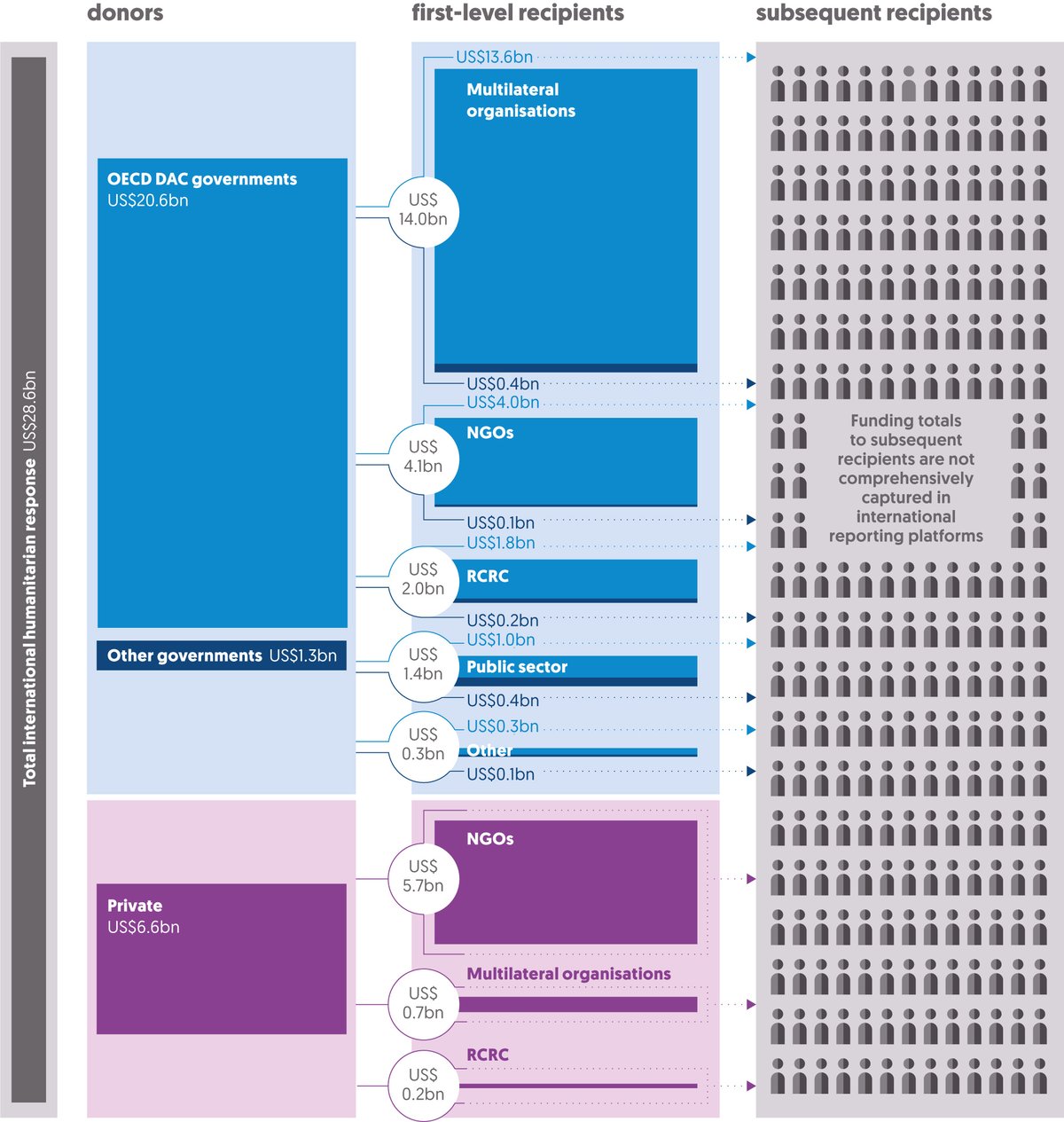
Funding channels of international humanitarian assistance, 2017
Source: Development Initiatives based on Organisation for Economic Co-operation and Development (OECD) Development Assistance Committee (DAC), UN Office for the Coordination of Humanitarian Affairs (OCHA) Financial Tracking Service (FTS) and UN Central Emergency Response Fund (CERF) data and our unique dataset of private contributions.
Notes: RCRC: International Red Cross and Red Crescent Movement. Our first-level recipient data from government donors and EU institutions uses OECD DAC Creditor Reporting System (CRS), UN Central Emergency Response Fund (CERF) and UN OCHA FTS data. The figures in our calculations for total humanitarian assistance from OECD DAC donors use data from OECD DAC Tables 1, 2a and ‘Members’ total use of the multilateral system’, so totals may differ. ‘Public sector’ refers both to the OECD definition and reporting to the FTS. OECD DAC CRS codes ‘other’, ‘to be defined’ and ‘public–private partnerships’ are merged to ‘other’. Private funding figures use our unique dataset of private contributions for humanitarian assistance. Data is in constant 2017 prices.
The available data provides a clear picture of how international humanitarian assistance is passed from donors to first-level recipients. In some cases, funding passes no further and is used directly to assist people in need. However, funding often continues to be passed to one or more intermediaries before reaching the crisis location. For these subsequent transactions data is more limited or entirely lacking. For funding to first-level recipients, the data indicates that patterns of funding allocation from public and private donors have varied little between 2013 and 2017.
- In 2017, governments directed almost two thirds (64%, US$14.0 billion) of international humanitarian assistance to multilateral organisations. This represented an increase from the 60% (US$12.6 billion) provided in 2016 but remained consistent with proportions allocated since 2013. These have fluctuated between a low of 58% in 2015 and a high of 65% in 2013.
- Private funding to multilateral organisations increased both proportionally and by volume between 2016 and 2017, from 10% (US$572 million) to 12% (US$767 million). This compares with an average from 2013 to 2017 of 10%.
- As in previous years, in 2017 most (85% or US$5.7 billion) international humanitarian assistance from private donors was channelled to NGOs. The proportion of total private funding to NGOs has remained consistent over the past five years with on average 86% passed directly.
- NGOs received less by volume from governments (US$4.1 billion) than from private donors in 2017. Direct funding to NGOs accounted for 19% of all government allocations in 2017, falling from 20% in 2016, though representing the same overall volume of US$4.1 billion.
- The international humanitarian assistance channelled by private donors to NGOs made up well over half (58%) of the total funding they received in 2017, consistent with the average of 58% during the period 2013 to 2017.
Funding to local and national actors
Figure 4.2: Direct funding to local and national actors grows in 2018 but remains a small proportion of all funding
Direct funding to local and national responders reported to UN OCHA FTS, 2018
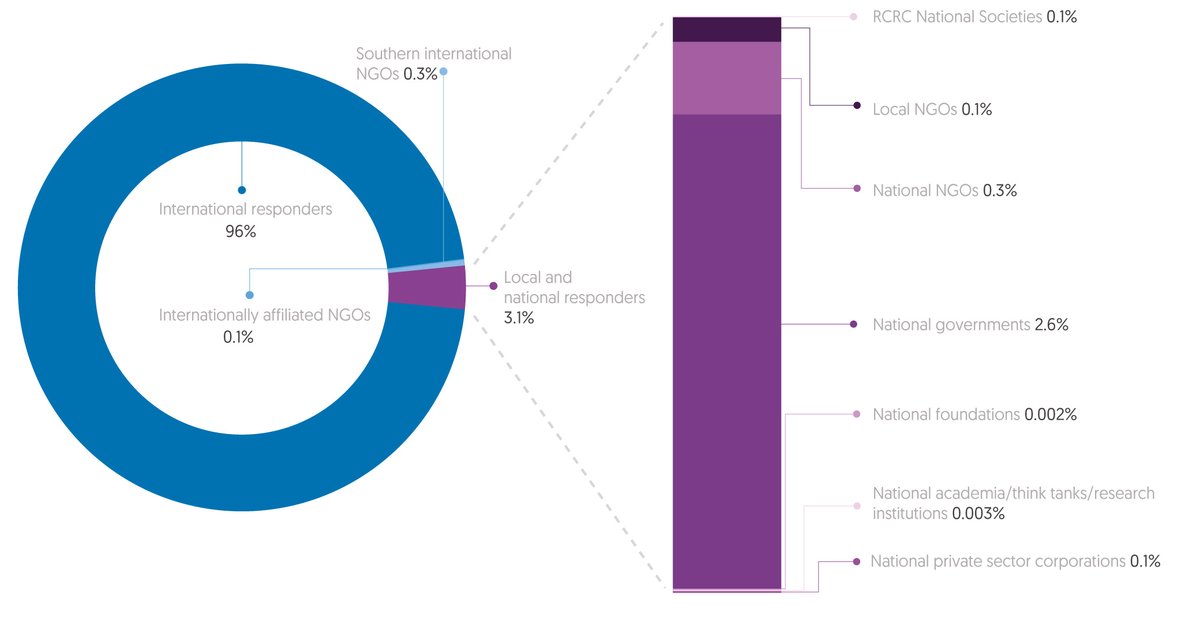
Direct funding to local and national responders reported to UN OCHA FTS, 2018
Source: Development Initiatives based on UN OCHA FTS data.
Notes: RCRC: International Red Cross and Red Crescent Movement. Government authorities in the Bahamas and Greece are counted as national responders since they received international humanitarian assistance in 2017. RCRC National Societies that received international humanitarian assistance to respond to domestic crises are included. For organisation-coding methodology, see our online Methodology and definitions.
Measuring progress towards the Grand Bargain’s 2020 “global, aggregated target of at least 25% of international humanitarian funding [passing] to local and national actors as directly as possible” remains challenging. [1] Direct funding to local and national actors has grown by volume and proportionally since 2016 but remains a small share of total humanitarian assistance.
- International humanitarian assistance sent directly to local and national responders as a proportion of all international humanitarian assistance increased for the second consecutive year. In 2016, 2.0% (US$433 million) was reported to FTS as having been directed to local and national responders, increasing to 2.8% (US$552 million) in 2017 and 3.1% (US$648 million) in 2018.
- Of funding flowing directly to local and national actors, national governments continued to receive the majority. The proportion of this direct funding passed to national government grew to 83% (US$538 million) in 2018, up from 80% (US$347 million) in 2016 and 81% (US$448 million) in 2017.
- Conversely, the proportion of direct funding to local and national actors received by local and national NGOs has fallen, from 17% of direct funding in 2017 to 15% in 2018.
- This decrease was driven by a fall in the amount of funding that went to national NGOs, from US$83 million in 2017 to US$65 million in 2018.
The working definition of funding passed “as directly as possible” includes funding that is transferred through one intermediary to a second-level recipient. [2] Consistent, comparable reporting of funding through one intermediary is very limited. In 2018, only 7.9% of the total volume of flows were reported to UN OCHA FTS at this second level, though this represents a slight increase from 7.1% in 2017. [3]
- The limited data reported to FTS indicates that funding provided to local and national responders directly and through one intermediary accounted for 3.8% (US$783 million) of total humanitarian assistance in 2018, up from 3.5% (US$681 million) in 2017.
- At country level, more comprehensive data collected in Uganda and Bangladesh indicates the proportions of funding passed directly and through one intermediary to local and national actors were significantly higher, at 8.4% and 9.7%, respectively. [4]
Pooled funds
Figure 4.3: Total pooled funding doubles since 2013 but increases more slowly as proportion of all assistance
Total funding to UN-managed humanitarian pooled funds, 2009–2018
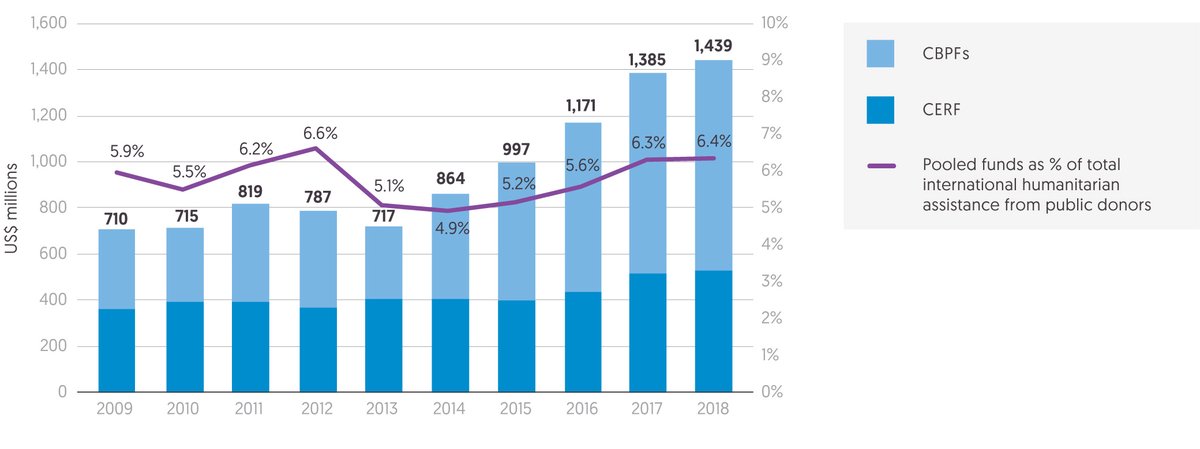
Total funding to UN-managed humanitarian pooled funds, 2009–2018
Source: Development Initiatives based on UN OCHA FTS and UN Central Emergency Response Fund (CERF) data.
Notes: CBPFs: country-based pooled funds. Data is in constant 2017 prices.
Pooled funds play an important role in humanitarian assistance, allowing for flexible and collective responses. UN and NGO-led funds can enable rapid responses and provide funding where gaps in other assistance are identified. Since 2013, the volume of total funding to UN pooled funds has doubled. Proportionally, the total public contributions to international humanitarian assistance that this represents has also increased, but at a slower rate.
- UN pooled funds received a record level of funding of US$1,439 million in 2018, the fifth consecutive year of growth and a 3.9% increase from the US$1,385 million contributed in 2017.
- Of this funding, country-based pooled funds (CBPFs) received US$911 million and the Central Emergency Response Fund (CERF) US$528 million.
- Funding provided to UN pooled funds has doubled since 2013 (from US$717 to US$1,439 million). However, sharp rises in total international humanitarian assistance over the same period mean that the proportion of all public donor contributions provided to these funds has grown by only 1.3%. These funds accounted for 6.4% of donor contributions in 2018, a return to a level just above the 6.0% three-year average between 2009 and 2012.
With the increase in overall funding to UN pooled funds, a growing share is directed to CBPFs and then passed onto NGOs.
- While funding to both CBPFs and the CERF has risen since 2013, the proportion of all funding allocated to each has shifted, with the share received by CBPFs growing from 43% in 2013 to 63% in 2018.
- CBPFs have disbursed an increasing proportion of their funding to NGOs, with allocations increasing by 139%, from US$201 million to US$482 million, between 2014 and 2018. This represents an increase from 52% to 65% in the proportion of total CBPF allocations passed to NGOs.
- 33% (US$158 million) of CBPF contributions to NGOs were channelled to local and national actors in 2018.
- The CBPFs receiving the largest allocations in 2018 were Yemen and Syria, which both had sharp increases in funding from 2017, rising by US$53 million to US$181 million and by US$25 million to US$112 million, respectively.
- The largest allocations of CERF funding in 2018 were to the Democratic Republic of the Congo (US$56 million) and Yemen (US$48 million).
The majority of funding to UN pooled funds has come from a small group of donors since 2014.
- Between 2014 and 2018, five countries provided nearly three quarters (73%) of all contributions to pooled funds: the UK (US$1.6 billion), Germany (US$809 million), Sweden (US$789 million), the Netherlands (US$653 million) and Norway (US$403 million).
Earmarking
Figure 4.4: Unearmarked funding to UN increases in total but continues to fall in relative terms
Earmarked and unearmarked international humanitarian assistance and humanitarian-related contributions to nine UN agencies, 2014–2018
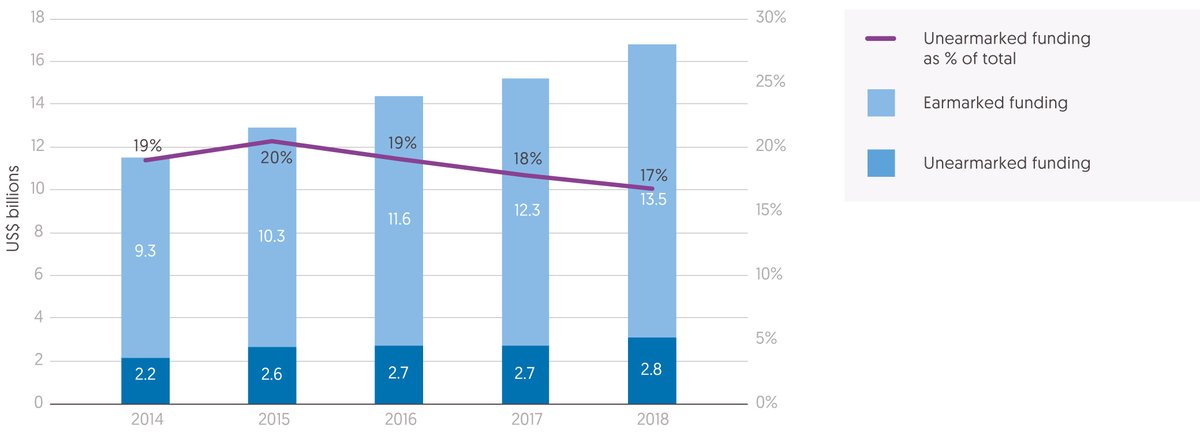
Earmarked and unearmarked international humanitarian assistance and humanitarian-related contributions to nine UN agencies, 2014–2018
Source: Development Initiatives based on data provided bilaterally by UN agencies.
Notes: The calculations comprise earmarked and unearmarked humanitarian and humanitarian-related contributions given to the Food and Agriculture Organization, International Organization for Migration, UN Development Programme, UN High Commissioner for Refugees, UNICEF, UN OCHA, UN Relief and Works Agency for Palestine Refugees in the Near East, World Food Programme and the World Health Organization. Data is in constant 2017 prices.
The Grand Bargain commitment to improve the flexibility of funding seeks to “achieve a global target of 30% of humanitarian contributions that is non-earmarked or softly earmarked by 2020.” [5] Regular and consistent reporting of unearmarked funding does not yet occur. [6] Data collected directly from nine UN agencies indicates that the proportion of unearmarked funding received by these agencies has declined steadily for the past three years.
- Between 2014 and 2018, unearmarked funding to nine UN agencies increased by US$604 million (28%) to US$2.8 billion. 79% of this total came from increases in unearmarked funding to the UN High Commissioner for Refugees (UNHCR) of US$305 million and to the UN Relief and Works Agency for Palestine Refugees in the Near East of US$173 million.
- Over the same period the volume of earmarked funding has increased at an even faster rate, rising by US$4.2 billion, an increase of 45%. Consequently, the proportion of funding reported as being unearmarked has incrementally fallen since 2015, from 20% to 17% in 2018.
The volume and proportion of total unearmarked funding received by individual UN agencies vary markedly between agencies.
- Unearmarked funding to the Food and Agriculture Organization (FAO), rose by 90% (US$4.4 million) in 2018, though this unearmarked funding still accounted for only 1.5% of FAO’s total budget. Unearmarked funding also increased to the UN Development Programme, by 25% (US$5.6 million), World Food Programme, by 19% (US$45 million), and UN OCHA, by 18% (US$19 million) in 2018.
- The World Health Organization, UNICEF and UNHCR all reported decreases in the volume of unearmarked funding received in 2018, falling by 16% (US$12.1 million), 9.7% (US$15.9 million) and 3.6% (US$48.4 million), respectively from 2017.
Multi-year funding
Figure 4.5: Multi-year funding grows markedly by volume but more slowly as a proportion of total funding
Single- and multi-year humanitarian-related donor contributions reported by Grand Bargain signatories, 2016–2018
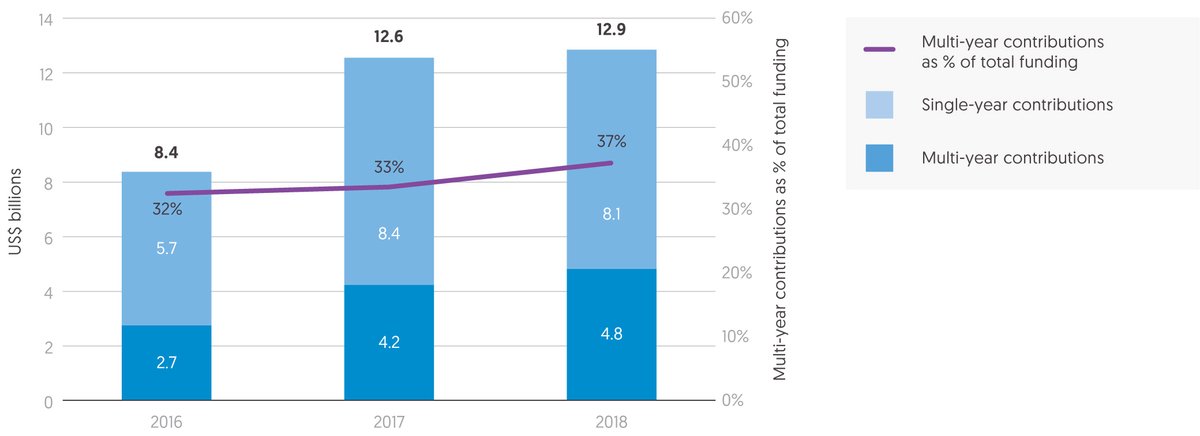
Single- and multi-year humanitarian-related donor contributions reported by Grand Bargain signatories, 2016–2018
Source: Development Initiatives based on data provided bilaterally and International Aid Transparency Initiative (IATI) data.
Notes: Data covers 11 institutional donors that are Grand Bargain signatories and reported to our survey. Multi-year funding also refers to funding agreements ranging between 12 and 24 months when defined as multi-year by the donor. UK Department for International Development data was collected from IATI and includes some technical operation costs. Data is in constant 2017 prices.
Multi-year funding provides predictable resourcing that can enable more efficient and effective delivery of assistance to people in need. Openly reported data on flows of multi-year funding from donors to first-level recipients and any subsequent passthrough of funding is limited (see Box 4.1). Independently collected data from donors and first-level recipients indicates that the volume and proportion of international humanitarian assistance provided as multi-year funding in 2018 has grown. [7]
- In 2018, multi-year funding accounted for 37% of total humanitarian-related contributions from 11 donors, increasing from 33% in 2017 and 32% in 2016.
- Between 2016 and 2018, the volume of funding reported as multi-year has grown from US$2.7 billion to US$4.8 billion, an increase of three quarters (75%).
There is no commonly applied definition of multi-year funding, either by time period of agreement or contract conditions. This hampers analysis and may in part explain the apparent disparity between the volumes of multi-year funding donors report granting and those that first-level recipients report receiving.
- Most donors reported that multi-year funding grants were those with a duration of 24 months or more.
- Where donors reported grants as multi-year with a duration of between 12 and 24 months, this accounted for 8% (US$922 million) of total multi-year funding reported from 2016 to 2018.
- In 2018, data collected from 10 agencies indicated that they received only 13% of funding as multi-year, compared with the 37% donors reported allocating.
Figure 4.6: UN agencies and international NGOs receive an increasing majority of multi-year funding
Multi-year contributions received by first-level recipients, 2016–2018
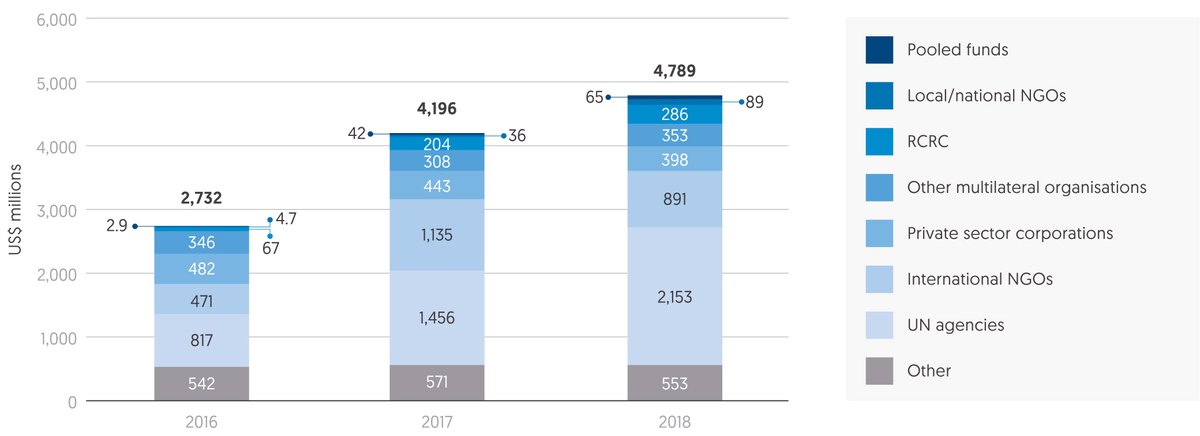
Multi-year contributions received by first-level recipients, 2016–2018
Source: Development Initiatives based on data provided bilaterally and International Aid Transparency Initiative (IATI) data.
Notes: Data covers 11 institutional donors that are Grand Bargain signatories and reported to our survey. Multi-year funding also refers to funding agreements ranging between 12 and 24 months when defined as multi-year by the donor. ‘Other’ includes academia/think tanks, government agencies, and undefined organisations. UK Department for International Development data was collected from IATI and includes some technical operation costs. Data for the EC was not captured for 2016. Multi-year data for Italy was not captured for 2016. Data is in constant 2017 prices.
The transfer of multi-year funding to implementing agencies is critical if it is to have a transformative impact on the delivery of assistance to people in need. Independently collected data shows that donors passed the largest volumes of multi-year funding to UN agencies and international NGOs. However, tracking data on subsequent transactions of multi-year funding beyond the first level remains challenging both at organisational and system-wide levels.
- Between 2016 and 2018, international organisations (UN agencies, international NGOs and other multilateral organisations) received a growing proportion of donors’ reported multi-year funding, increasing from 60% (US$1,634 million) to 71% (US$3,397 million).
- Among these international organisations, UN agencies received the largest proportion, up from 30% (US$817 million) in 2016 to 45% (US$2,153 million) in 2018.
- Direct multi-year funding to local and national actors and pooled funds has increased sharply between 2016 and 2018 and was 19 and 22 times greater respectively in 2018. Yet despite this growth, local and national actors directly received only 2% of total reported multi-year contributions and pooled funds received only 1%.
Box 4.1
Data availability for multi-year funding
The Grand Bargain commits aid organisations and donors to “increase multi-year, collaborative and flexible planning and multi-year funding instruments”. [8] However, in the absence of common agreement on how to measure the targets and baselines, and of sufficiently standardised reporting of data, these contributions are not yet systematically recorded.
Current data availability
- Reporting to UN OCHA FTS flow model allows the identification of funding across multiple years, by source and destination usage years. While this enables the years covered by a funding flow to be identified, the absence of a multi-year marker prevents identification of intentional multi-year grants. For example, cost extensions to single-year grants might appear as spanning multiple years or funding that covers a 12-month period but runs across two years might also appear as a multi-year flow. More comprehensive reporting to FTS relies on having an agreed set of definitions for multi-year funding.
- The International Aid Transparency Initiative (IATI) Standard enables reporting at activity level with clear start and end dates and can therefore capture projects spanning multiple years. The volumes of humanitarian funding reported to IATI are however currently limited and again still depend on there being agreed definitions of what constitutes multi-year funding.
Reporting of multi-year funding is hampered by various factors:
- Absence of a shared lexicon: Within institutions there may not yet be definition and classifications of multi-year funding, relating to issues such as duration of contracts and their diverse terms. Across organisations this terminology gap expands further, leading not only to the lack of a common framework to report against, but also to divergent understandings of multi-year funding. This could prevent reconciling donors’ spending with first-level recipient agencies’ income, as well as quantifying grants and what they subsequently enable at programmatic level.
- Limited monitoring and reporting of effectiveness and efficiency: Accurately and comprehensively recording volumes of multi-year funding is important. Perhaps of greater importance still, is shifting from primarily reporting income and expenditure by organisation to also measuring programme outcomes to determine effectiveness and efficiency.
- The challenge of capturing humanitarianand broader development funding: A broader focus beyond pure humanitarian funding is needed to record not only contributions towards appeals, but also to capture the broader response that these grants enable.
- Lack of clarity on purpose of multi-year grants: More purposeful reporting can be enabled by agreeing whether to measure results individually or collectively, whether these are expected to elicit efficiency and effectiveness gains – and the extent to which these gains are demonstrated at different layers in the transaction chain – and/or deliver better outcomes.
Cash
Figure 4.7: Volume of cash and voucher programmes reaches new high
Total international humanitarian assistance for cash and voucher programmes, 2015–2018

Total international humanitarian assistance for cash and voucher programmes, 2015–2018
Source: Development Initiatives based on data provided bilaterally by implementing agencies, the Cash Learning Partnership and UN OCHA FTS.
Notes: RCRC: International Red Cross and Red Crescent Movement. Data for 2018 is preliminary. Double counting of cash and voucher assistance programmes that are sub-granted from one implementing partner to another is avoided where data was provided. Programming costs are estimates for organisations that only provided the amount transferred to beneficiaries. Data is not available for all included organisations across all years, for instance the RCRC started to systematically track cash and voucher assistance in 2017. Data is in current prices.
Cash-transfer programming can enable recipients to choose how best to meet their needs, with the potential to offer gains in dignity. More agencies are now tracking their cash-transfer programming but challenges remain and openly reported data is limited. Data collected directly from donors and agencies by Development Initiatives indicates that while volumes of humanitarian cash and voucher assistance continued to rise to a record US$4.7 billion in 2018, the pace of growth is slowing.
- Global volumes of humanitarian cash and voucher assistance programming grew by 10% from 2017 to 2018.
- This growth was largely driven by an increase in cash and voucher assistance programming by UN agencies (increasing by 25% to US$2.8 billion). Volumes implemented by NGOs and the International Red Cross and Red Crescent Movement (RCRC) remained at a similar level although they decreased slightly as a proportion of total global cash and voucher assistance (from a combined 46% to 40%).
- The apparent increase of US$1.5 billion from 2016 to 2017 in the global volumes of cash and voucher assistance programming was mostly due to newly available data from the RCRC.
- Discounting this previously unavailable data, growth from 2016 to 2017 in the global volume of cash and voucher assistance programming was 21%, down from a 38% increase from 2015 to 2016.
Figure 4.8: Cash increasingly preferred to vouchers
Proportions of cash and vouchers in humanitarian cash and voucher assistance, 2015–2018
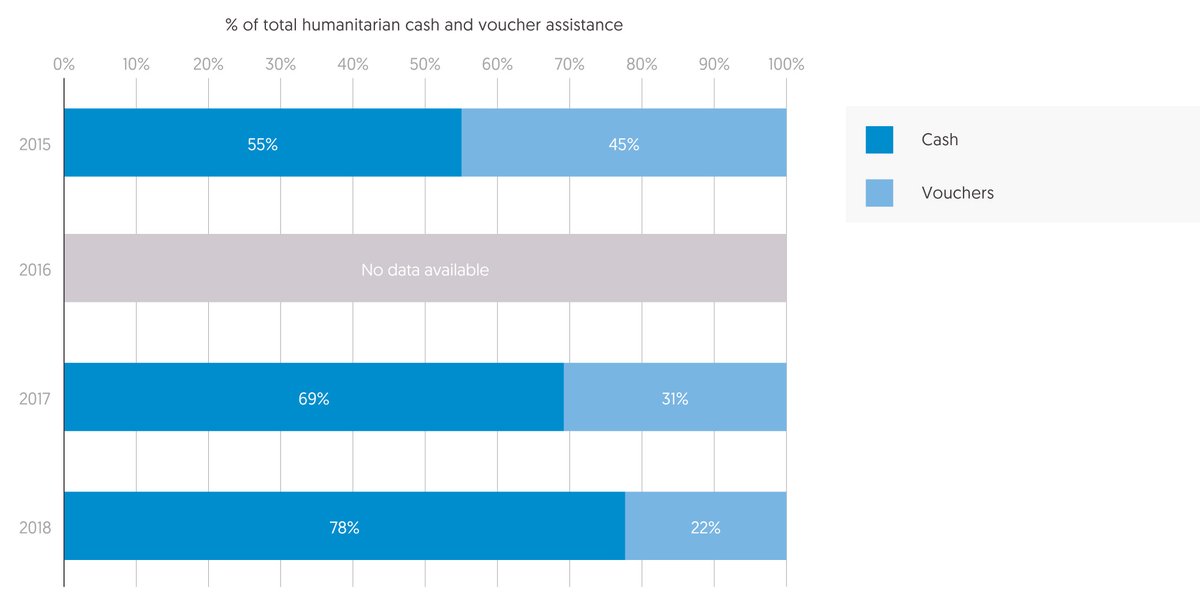
Proportions of cash and vouchers in humanitarian cash and voucher assistance, 2015–2018
Source: Development Initiatives based on data provided bilaterally by implementing agencies.
Notes: Data for 2018 is preliminary. No data is available for 2016. Data for all but one organisation refers to amounts transferred to beneficiaries. Data is not available for all included organisations across all years, for instance the RCRC started to systematically track cash and voucher assistance in 2017.
An increasing proportion of cash and voucher assistance has been transferred to beneficiaries in the form of cash since 2015, compared with vouchers.
- In 2015, there was a roughly equal split between the use of cash for transfers, at 55% and vouchers, at 45%. However, by 2018 the preference for using cash is much more distinct, accounting for 78% of transfers. Meanwhile vouchers were used in just 22% of transfers.
- The growing proportion transferred in the form of cash is largely driven by a shift in the practice of UN agencies, with their use of cash for transfers growing from 45% in 2015 to 72% in 2018. [9]
- Both NGOs and the RCRC have consistently preferred the use of cash for transfers. In 2018, NGOs transferred 78% and RCRC 95% as cash – a slight decrease from 2017 for NGOs, from 84%, [10] and a rise for the RCRC, from 82%.
Downloads
Notes
-
1
Grand Bargain signatories, 2016. The Grand Bargain – A Shared Commitment to Better Serve People in Need. Available at: www.agendaforhumanity.org/initiatives/3861Return to source text
-
2
IASC Humanitarian Financing Task Team, 2018. Localisation Marker Working Group: Definitions Paper. Available at: https://interagencystandingcommittee.org/system/files/hftt_localisation_marker_definitions_paper_24_january_2018.pdf . The definitions paper defines ‘as-directly-as-possible’ funding as that passed through “a single international aid organisation” but notes that further research and discussion are planned to consider whether other intermediaries should be considered for inclusion.Return to source text
-
3
This 7.9% relates to external flows at the second level. In 2018, a total of 16% of flows on FTS were at second level, though this includes ‘internal’ transfers of funding within an agency, where an agency reports funding as a donor but the recipient of the funding is another part of the same agency.Return to source text
-
4
Oxfam, Development Initiatives and Uganda Comprehensive Refugee Response Framework Steering Group (forthcoming). Money Talks II: Uganda. And Oxfam (forthcoming). Money Talks II: Bangladesh.Return to source text
-
5
See note 1.Return to source text